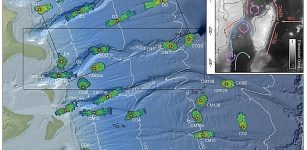Anomaly In the Deep Sea – Ocean Currents, Stellar Explosion Or Interstellar Collision
Eddie Gonzales Jr. – MessageToEagle.com –Radionuclides are isotopes that decay over time, used to date archaeological and geological samples. Radiocarbon dating is a well-known method.
Schematic depiction of production and incorporation of cosmogenic 10Be into ferromanganese crusts. A pronounced anomaly in 10Be concentration about 10 million years ago was discovered. This anomaly has great potential as time marker for the Late Miocene. ©Copyright: HZDR / blrck.de
In principle, radiocarbon dating is based on the fact that living organisms continuously absorb the radioactive isotope carbon-14 (14C) during their lifetime. Once an organism dies, the absorption ceases, and the 14C content starts to decrease through radioactive decay with a half-life of approximately 5,700 years.
By comparing the ratio of unstable 14C to stable carbon-12 (12C), researchers can determine the date of the organism’s death.
Archaeological finds, such as bones or remnants of wood, can be dated quite accurately in this way.
“However, the radiocarbon method is limited to dating samples no more than 50,000 years old,” explains HZDR physicist Dr. Dominik Koll. “To date older samples, we need to use other isotopes, such as cosmogenic beryllium-10 (10Be).” This isotope is created when cosmic rays interact with oxygen and nitrogen in the upper atmosphere.
It reaches the Earth through precipitation and can accumulate on the seabed. With a half-life of 1.4 million years, 10Be decays into boron, allowing geological dating that can extend back over 10 million years.
Conspicuous accumulation of beryllium
Some time ago, Koll’s research group examined unique geological samples retrieved from the Pacific Ocean at a depth of several kilometers. The samples consisted of ferromanganese crusts, primarily composed of iron and manganese, which had formed slowly but steadily over millions of years.
To date the samples, the team analyzed the 10Be content using a highly sensitive method – Accelerator Mass Spectrometry (AMS) at HZDR. In this process, the sample is chemically purified before undergoing analysis for trace isotopes. Individual atoms from the sample are accelerated by high voltage, deflected by magnets, and then registered by specialized detectors.
This method allows for the precise identification of 10Be, distinguishing it from other beryllium isotopes as well as molecules and isotopes with the same mass, such as boron-10.
When the research group evaluated the collected data, they were in for a surprise. “At around 10 million years, we found almost twice as much 10Be as we had anticipated,” reports Koll. “We had stumbled upon a previously undiscovered anomaly.” To eliminate any possibility of contamination, the experts analyzed additional samples from the Pacific, which also exhibited the same anomaly. This consistency allows the team to conclude that it is indeed a real phenomenon.
Ocean currents, stellar explosion or interstellar collision?
But how did such a striking increase in concentration come about 10 million years ago? Koll, who completed his doctorate at the TU Dresden and the ANU, proposes two possible explanations. One is related to the ocean circulation near Antarctica, which is thought to have changed drastically 10 to 12 million years ago. “This could have caused 10Be to be unevenly distributed across the Earth for a period of time due to the altered ocean currents,” explains the physicist. ”As a result, 10Be could have become particularly concentrated in the Pacific Ocean.”
The second hypothesis is astrophysical in nature. It suggests that the after-effects of a near-Earth supernova could have caused cosmic radiation to become temporarily more intense 10 million years ago. Alternatively, the Earth might have temporarily lost its protective solar shield – the heliosphere – due to a collision with a dense interstellar cloud, making it more vulnerable to cosmic radiation. ”Only new measurements can indicate whether the beryllium anomaly was caused by changes in ocean currents or has astrophysical reasons,” says Koll.
”That is why we plan to analyze more samples in the future and hope that other research groups will do the same.” If the anomaly were found all over the globe, the astrophysics hypothesis would be supported. On the other hand, if it were detected only in specific regions, the explanation involving altered ocean currents would be considered more plausible.
The anomaly could be extremely useful for geological beryllium dating. When comparing different archives for dating, one fundamental problem arises. Common time markers must be identified in all data sets so they can be properly synchronized with each other. Dominik Koll explains, “For periods spanning millions of years, such cosmogenic time markers do not yet exist. However, this beryllium anomaly has the potential to serve as such a marker.”
Written by Eddie Gonzales Jr. – MessageToEagle.com Staff Writer











